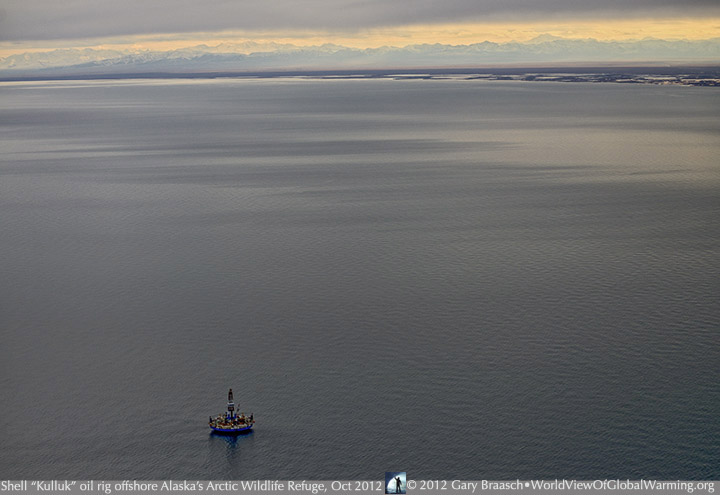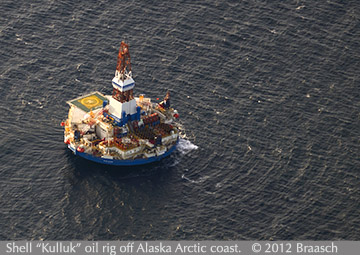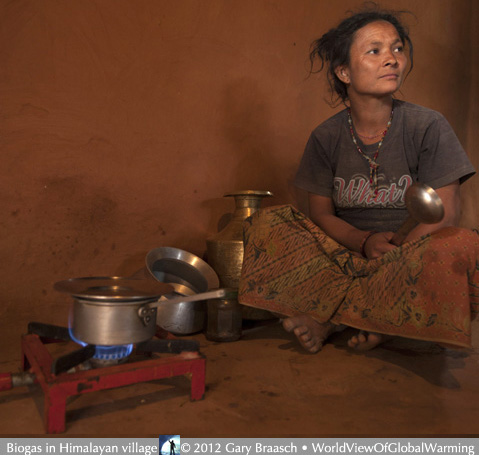Climate Photo of the Week
Shell's new oil drill rig just offshore in Alaska's Arctic Ocean -- expanding petroleum extraction in an Arctic already changed by fossil fuel use.
Portfolio of images here.
First aerial photos, taken October 7, 2012, of the Royal Dutch Shell floating oil drilling unit, the Kulluk, in the Beaufort Sea, as it prepares to begin initial work on an exploratory oil well beneath the Arctic Ocean floor north of Alaska. The drill rig is only 12 miles offshore of the Arctic National Wildlife Refuge. Oil drilling has been kept out of the refuge through decades of Congressional battles, and the public probably does not realize how close this new off-shore well site is to a place they consider protected. The 160 foot high Kulluk rig is anchored above a Federal oil prospect explored in the 1980s and 90s by other oil companies -- but there has been no oil prospecting or drilling in these waters since then. Like the Arctic Refuge, the Arctic Ocean coastal zone is rich with migrating birds, fish and marine mammals, and is also a source of native Inupiat culture and food. Kaktovik, the nearest Alaska native village to the Shell rig is 60 miles to the east. As seen in these photos, no ice is visible on these pristine waters; the summer Arctic Ocean sea ice cover shrank this year to the smallest ever recorded. Shell still does not have the final approval from the Interior Department to actually drill down to oil-bearing strata this year. But the drill rig is in place now to do preliminary work as soon as the Kaktovik community finishes its fall whale hunt. The rig is supposed to leave the site for the winter by October 31.
In addition to the Kulluk, Shell has another drill ship, the Noble Discoverer, anchored above an oil prospect 70 miles off the Western Alaska coast north of the Bering Strait. These are the the latest steps in a five year process of technical permit requirements, equipment preparation, and environmental permissions sought by Shell in order to be the first company to drill for oil production on the U.S. Arctic continental shelf. The process has been delayed this summer by failure of Shell to complete the building of an oil spill containment vessel on time for this year's work, the presence of ice in the Chukchi Sea (despite the overall low ice amount), and increased demands for oversight and oil spill recovery preparations in the wake of the Gulf Oil Spill. The oil industry already has a huge footprint across more than 50 miles of the central Arctic coast tundra centered on Prudhoe Bay and the Trans Alaska Pipeline, but has been kept away from the Arctic Refuge.
Environmental and native groups, long critical of the damage caused by oil production and spills and the role of oil use in global warming, have pressed Interior and the EPA to be more stringent in the permitting process and to disallow ocean drilling because it would degrade air quality and could damage the ocean ecosystem in an oil spill. Ten groups have argued that there is not enough information about the Arctic ecosystem to make informed decisions about where the least cumulative impacts will occur, that the Clean Air Act has been violated, that a full environmental analysis has been lacking, and that the approved oil spill response plans are inadequate because clean up in the frigid and usually ice-covered Arctic is untested. Many scientific studies are underway on the tundra and in the ocean to try to understand not only the ecosystems, but also the ongoing effects of global warming, which are intensifying in the North. Already scientists can document increased CO2 and methane emissions from thawing permafrost and describe some of the ominous implications of loss of Arctic sea ice for weather and wildlife.
Portfolio of images here.
Water, Land, Farming and Climate Change in the Himalaya
Sangita Gahle cooks on her biogas stove in the smoothed clay common room of her home, making chai for us while we enjoy talking about families and her joy in cooking with gas on her farm in Pairebensi, near Betrawati, Nepal. The simple technology is part of a worldwide drive to cut back on emissions of black carbon -- smoke and fumes from burning wood and fuels -- because of their ill effects on human health and large contribution to global warming. We are beginning a new series of photo-stories from our journey to Nepal and India earlier this year, beginning with stories about water, landslides, and cookstoves. Our travel in the Himalayas is thanks to generous funding from the Karuna Foundation - US to report on how climate change is affecting the lives of mountain people in Nepal, India and Bhutan.
Portfolios: Water | Landslide | Cookstoves

COPYRIGHT NOTICE:
Photography and text Copyright © 2005 - 2017 (and before) Gary Braasch All rights reserved. Use of photographs in any manner without permission is prohibited by US copyright law. Photography is available for license to publications and other uses. Please contact requestinformation@worldviewofglobalwarming.org. View more of Gary Braasch's photography here.





